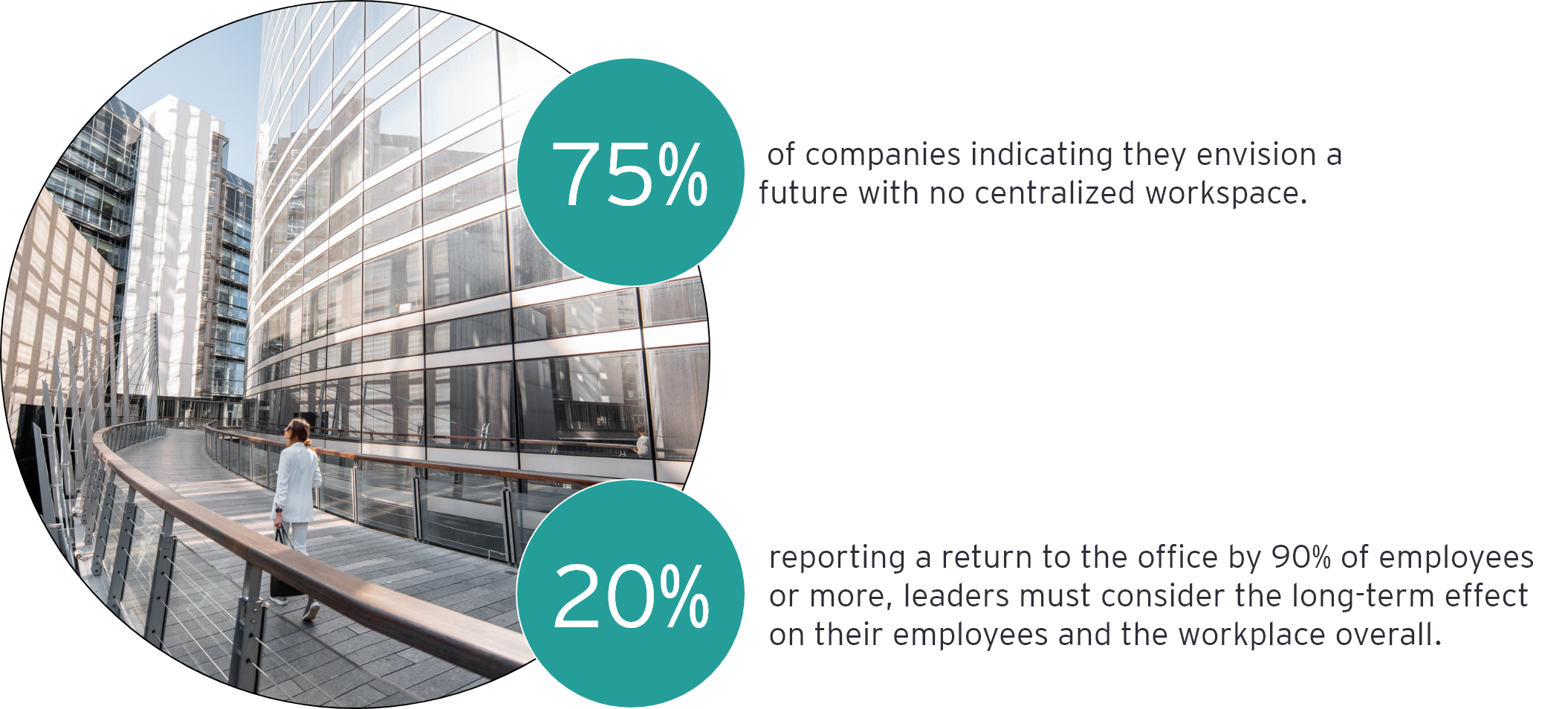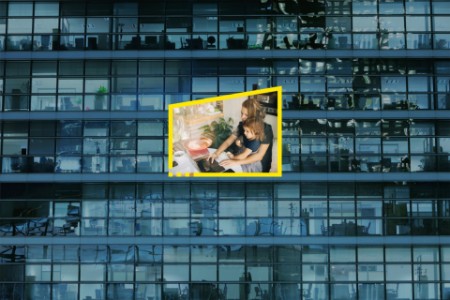Where do you work?
The whole notion of the workplace is evolving. We know one big reason why, but we also know that the incremental shift toward decentralization, especially for knowledge-driven organizations, predates early 2020.
What we didn’t know was exactly how the working world has been reshaping itself since the advent of the COVID-19 global pandemic — until now. Our inaugural EY Future Workplace Index, one of the first of its kind, offers a new window into the office. And wherever you sit or stand, the new normal is hybrid.
The concrete EY survey data signals a sea change for the traditional nine-to-five office-based environment — but there’s positive news about productivity, culture and collaboration.

The future is hybrid.
Here’s what we know now.
Yes, companies are slowly migrating employees back to the office, but there is no return to “normal,” and 87% of companies say the pandemic has permanently changed the role of the physical office for their organization.

Employer considerations
Some employees are inspired by the opportunity to work from home, gladly channeling energy they previously spent on an unpredictable commute, child or pet care arrangements, or professional dress and appearance, back into their daily work itself. Others may feel unmotivated, isolated and deprived of personal interaction and camaraderie, especially if they are working in a near-empty office. Still others may consider themselves invisible to their leadership and struggle to keep work performance up to usual and expected levels.
In general, the EY Future Workplace Index reveals that companies expect to end up with about 35% of their workforce full time in the office, compared to 45% pre-pandemic, and another 45% using it for some of the work week. With 27% of employees already back in the office full time, the migration to the future model is well over halfway complete.
In this new working world, the EY Future Workplace Index reveals that employers are concerned by a number of factors, including fairness and equity, retention of talent, and maintaining culture, creativity and collaboration.
Other worries include effective meeting management, reduced collaboration among teams, a decrease in mentoring both formal and informal, and employee burnout due to a lack of delineation between work and home life.
“Hybrid work is here to stay, yet leaders aren’t creating the policies needed for hybrid success and the consequences could be significant. Employees don’t want to work in an ambiguous environment, and talent retention and attraction is on the line,” says Mark Grinis, Global Real Estate, Hospitality & Construction Leader, Ernst & Young LLP. “We know the pandemic’s effect on future workplaces is significant, and this index reveals there is a critical gap, and guidelines are needed to maximize sustained workplace success in a hybrid environment.”
A thoughtful, firm and well-governed hybrid work plan, created and supported from the leadership level, can clarify expectations and align work styles to maintain effectiveness and productivity across organizations of all sizes and sectors.
What is the business impact of these seismic shifts?
The news is largely positive. Company leaders responding to the EY survey report that four significant business areas have improved by pre-COVID-19 measures — productivity, culture, well-being, and operations and processes.
A clear plan for the hybrid workplace is critical.
When it comes to the future workplace, leaders are looking for guidance and are exploring hybrid frameworks, but there is no one-size-fits-all solution to help companies navigate these complex decisions. Companies need to put the right health protocols, office space, technology, and processes in place for their organization to make data-driven decisions in this new world of work, all while keeping flexibility, collaboration and well-being top of mind for employees.
Office doors are open, but a hybrid model is the new normal for most companies.
The chart below shows a breakdown of workplace practices by company size and percentages of workforce — pre-COVID-19, current approaches and what’s anticipated for the future.

Here's a flyover of major industry sectors.
Although most employers expect more staff to return to the office, they don't expect office use to return to pre-COVID-19 levels.

Seventy-five percent of companies anticipate having no central office location moving forward.
Two years ago, according to our Work Reimagined Employee Survey, only 3% of companies surveyed were operating with a fully remote workplace model for 90% or more of employees. Nearly half of employees worked full time in the office, and another 40% used it for at least part of the week, so a sizeable majority (85%) of employees were at least somewhat dependent on the office for their go-to workspace.
As of August 2021, 27% of employees are back in the office full time, compared to 45% pre-COVID-19. The number of those working exclusively from home has risen from 14% to 31%. Only 13% of companies expect to have 90% or more of employees in the office full time post-COVID-19.
Companies that the EY organization surveyed already showed a fairly even distribution of work taking place in the office, at homes or remote locations, or both. Business organizations should be prepared to support employees working from multiple locations. The role of real estate office markets in urban centers will vary based on the presence of financial services and related companies where an in-office model is still a priority.
There is no one-size-fits-all.
Currently, the hybrid approach is not serving all major sectors.
The insurance industry is readily adapting to a remote-work environment, and we expect that large firms may sustain a remote model while smaller insurance firms continue the evolution to hybrid.
But in the technology and banking sectors, large firms are finding their current workplace management and results are less effective than before — in contrast to small- to mid-sized companies that are finding it easier to adjust and thrive in a hybrid workplace.
Based on our research,
We anticipate that larger tech and finance firms will pursue an “office-first” hybrid approach in the post-COVID-19 environment.
The balance is shifting
Companies expect to end up with about 35% of staff full time in the office, compared to 45% pre-COVID-19. The pandemic will have a lasting and material impact on office use.
Our research indicates that hybrid workers will increase from 40% to 45% and fully remote workers from 15% to 20%.
Where’s your function?
Moving forward, while most departments will use a hybrid workplace model, some business functions are more effectively performed in an office or onsite work setting.
For example, core business personnel delivering client-facing and customer-facing services will remain the most office-based roles. By contrast, call centers are likely to be remote. Business considerations call for a balance of the costs of technology and office space against the revenue potential of personal interaction.
Among the 57% of companies that reported improved productivity, the key areas of improvement are operations and processes (67%), administration (64%), employee collaboration (61%), and internal meetings (61%). Across all metrics, 70%–85% of respondents say their current work approach is as or more effective than it was pre-COVID-19. Work locations will increasingly become role-specific. For individual companies, it’s a matter of finding what balance actually works.
There is no standard hybrid working plan, but new work standards are evolving in time.
The landscape doesn’t look the same for everyone. There is an emerging understanding that the future hybrid workplace will require a bespoke approach tailored to specific industry, company and employee needs. More than ever, bold corporate leadership will be defined by a combination of data-driven decisions and the vision to set trends rather than follow them.
The EY Future Workplace Index shows that the three critical areas in play are real estate, or workspace investment; technology capabilities that not only support, but advance business needs; and people strategies that help company culture flourish rather than languish.
For employers across sectors, the stakes are high. Many companies have faced steep attrition and loss of revenue due to economic uncertainty, sagging corporate confidence and a recently decentralized workforce that’s easily pulled off course by this new version of mission drift.
But our survey data shows positive signs for productivity, work culture, employee well-being, and even business operations. Unprecedented times can set new precedents and create greater promise for the future, if leaders take action to seek out the right data and trusted guidance.
Conclusion
The first EY Future Workplace Index confirms that the events of the past two years have profoundly and permanently changed the way our world works.
- Flexibility is imperative for future success. Production is not tethered to an office desk, collaboration is not confined to a conference room, leadership can be both virtual and meaningful, and a coffee pot at home can brew connections as strong as the one in the break room.
- We bring this knowledge to companies that are still finding their own new normal.

